INTRODUCTION
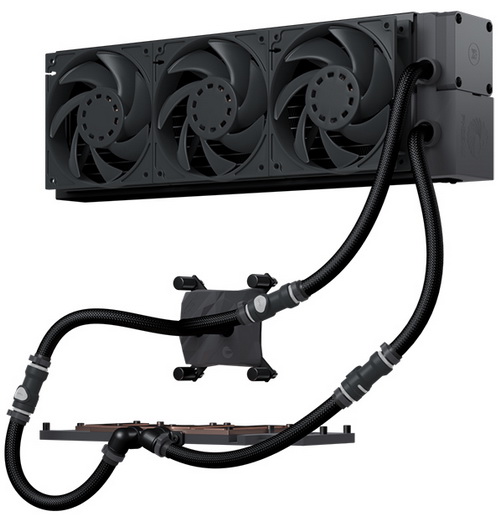
If you're gathering parts for a new system and you want to enter the world of water cooling there are three choices currently available in the market for you. The first and most popular is AIO closed loop liquid CPU coolers which offer a great performance/cost ratio and thanks to the countless models out there you can easily find exactly what suits your needs. Second we have expandable AIO liquid CPU coolers and although these are usually not as affordable as their closed loop counterparts they usually offer better cooling efficiency and can also be used to cool your graphics card or cards (by using extra parts of course). Finally we have complete / custom water cooling kits which may offer superior cooling performance (do keep in mind that this is not a rule so exceptions do exist) and looks compared to AIO models but they are not only more expensive but also much harder to install. EK Waterblocks released their first generation of expandable AIO liquid CPU coolers back in late 2015 called the Predator MLC (modular liquid cooling) and after a very successful 2-year run they released its successor the Phoenix MLC which we ended up testing for the better part of July.
EK Water Blocks bears the name of its founder Edvard Konig, who started experimenting with liquid cooling in 1999. From the humble beginnings in the early years of the previous decade, the company grew steadily to become a global premium liquid cooling gear manufacturer. Today, EKWB offers a complete range of products for liquid cooling, from a renowned Supremacy line of CPU water blocks, wide range of in-house developed CoolStream radiators, Vardar high-static pressure fans, Phoenix Modular Liquid Cooling (MLC) solution, bringing affordable Fluid Gaming aluminum liquid cooling products to the market and providing overclocking enthusiasts, PC builders with the best of what the market can offer. With continuous research and design, we will always strive to bring best possible liquid cooling performance and experience to our customers all around the world.
Unlike AIO liquid CPU coolers the Phoenix MLC by EK Water Blocks consists by up to three pre-filled (with EK-CryoFuel) parts the main core module (radiator), CPU cooling module (CPU waterblock) and the GPU cooling module (GPU waterblock). Of course it goes without saying that you can use just the core module with any or both of the two currently available cooling modules (for example for this review we only used the CPU cooling module since we wanted to get comparable results to other AIO models). All three components feature quick disconnect couplings (QDC) for quick and tool-less expansion of the system without first having to drain the entire unit (zero drop design). The core module features an EK-Coolstream PE 360 radiator, custom SPC water pump (6W operating power with 250 liters per hour flow rate and 3.2m maximum pressure), three high-static pressure EK-Vardar EVO 120ER fans (2200RPM/77CFM/3.16mmH2O/33.5dBA) and two 255mm long (not including QDC) EK-ZMT 10/15 sleeved tubes. The CPU cooling module on the other hand is based on the EK-Supremacy waterblock and also features two 145mm long (QDC not included) braided tubes and LED illumination. As for the GPU cooling module it's based on a full-cover copper waterblock (split-flow cooling engine for optimal cooling) which is compatible with multiple NVIDIA (Titan X and GTX models) and AMD (Radeon Vega) graphics cards.
SPECIFICATIONS AND FEATURES

PACKAGING AND CONTENTS
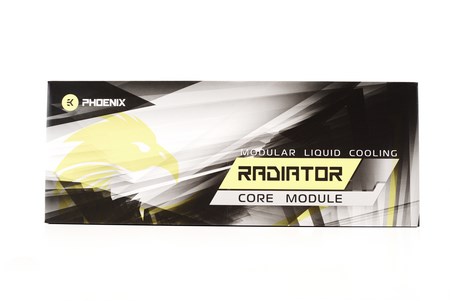
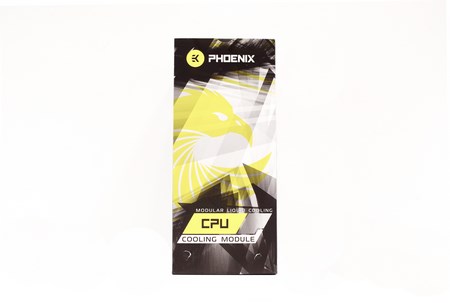 The Phoenix MLC core and CPU cooling modules arrived inside black, white, gray and yellow boxes which have the product name at the front along with a partial drawing of a Phoenix.
The Phoenix MLC core and CPU cooling modules arrived inside black, white, gray and yellow boxes which have the product name at the front along with a partial drawing of a Phoenix.

 On the left side you can see the three available parts with the contained module highlighted with yellow color.
On the left side you can see the three available parts with the contained module highlighted with yellow color.

 A short warning about mixing copper and aluminum parts is printed on the right side.
A short warning about mixing copper and aluminum parts is printed on the right side.

 All of the modules along with the quick disconnect couplings are showcased at the rear of the box.
All of the modules along with the quick disconnect couplings are showcased at the rear of the box.

 At the base of the core module box you will find two stickers containing its parts and a drawing showcasing its size while at the base of the CPU cooling module there's a sticker with the compatibility of the included model (different model for the TR4 socket).
At the base of the core module box you will find two stickers containing its parts and a drawing showcasing its size while at the base of the CPU cooling module there's a sticker with the compatibility of the included model (different model for the TR4 socket).

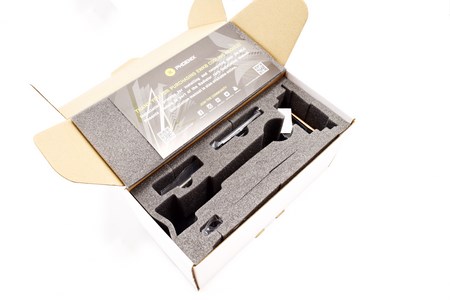
Both bundles are placed inside plastic bags and in formed piece of foam.
Along with the core radiator inside the box you will also find three plastic bags with fan case screws, SATA power connector, two pin to three pin fan connector and the user guide.
The Intel/AMD CPU cooling module comes with a small thermal paste tube, two backplates, thank you note and all the necessary screws to mount it onto Intel LGA1150/1151/1155/1156/2011/2011-3/2066 and AMD AM4 compatible mainboards.
THE CORE MODULE
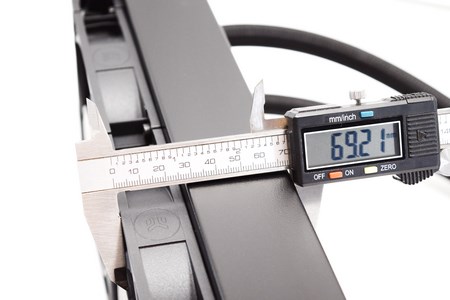

Since the Phoenix MLC core module comes with all three fans pre-installed it's quite thick at roughly 69mm which is to be expected since the radiator alone is roughly 43mm thick.
The EK-Coolstream PE 360 radiator features a high FPI (fins per inch) count of 23.
On one end of the radiator we find the EK-SPC water pump (right) and the compact reservoir (left) which holds 280ml of EK-CryoFuel liquid.
Instead of using silver fittings like their Predator line EK Waterblocks has chosen to go with plastic ones for the Phoenix model (not as eye catching but they get the job done).
Although the EK-Vardar EVO 120ER fans are nothing fancy in terms of design (no LEDs either) they are among the highest quality models in the market today (you can also reverse the fans to suck air from the outside thus improving cooling efficiency).


On the left of the fans we see an fill port while on the right we see the fan hub, power port and LED and a drain port.

 The EK-ZMT 10/15 sleeved tubes used with the core module are 255mm in length and feature quick disconnect couplings (the rubber balloon of course needs to be removed).
The EK-ZMT 10/15 sleeved tubes used with the core module are 255mm in length and feature quick disconnect couplings (the rubber balloon of course needs to be removed).
THE CPU COOLING MODULE
The CPU cooling module is basically an EK-Supremacy waterblock with two EK-ZMT 10/15 sleeved tubes (145mm in length) attached onto it.
Ontop of the waterblock we find the Phoenix logo (illuminated) and name.
The LED is powered by a four pin mainboard connector.
Again both sleeved tubes end on quick disconnect couplings and a rubber balloon which needs to be removed.
The high-quality all-copper base of the waterblock features a mirror-like finish.
Once both balloons are removed you can go ahead and match the quick disconnect couplings as seen above.
With both modules attached the length of the tubes (QDC included) goes up to 465mm.
If you ever need to remove or expand the system you can disconnect the two parts by pressing the buttons found on both couplings.
TEST BED
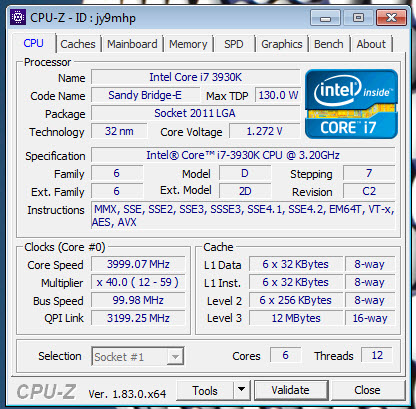

TESTING METHODOLOGY
Testing complete water cooling kits or individual radiators is no different than testing CPU Coolers and since we want all of you to be able to compare similar products we created new and separate charts (you can still cross-compare results however since we are using the same test rig). So once again single (120/140mm) watercooling solutions are tested with the radiator mounted at the rear of our test rig while dual/triple/quad (240/260/280/360/420/480/560mm) solutions with the radiator mounted at the top. For the dBA tests complete water cooling kits or radiators with bundled fans are measured both while on idle mode or with the fan controller in the minimum setting and while on extreme load or with the fan controller all the way to the highest possible setting (PWM fans do that on their own without our intervention). Every single test takes place in a temperature controlled room of 23 degrees Celsius Ambient Temp with the help of two AC units placed diagonally inside the room. When testing complete water cooling kits we use the Arctic Silver 5 thermal paste. Finally much like when testing CPU Coolers it's very important to point out that just because a water cooling kit outperforms another when tested with our test rig (when we test complete water cooling kits) that does not necessarily mean that the same performance differences will apply 100% for other CPU models and in other situations (such as different ambient temps and system configurations).
To successfully record the load temperatures we use the latest OCCT application for around 6-10 minutes to push the processor to its limits and after that is done and the temperatures are recorded we wait for about 10-20 minutes for the CPU to cool down and record the idle temperatures. This is done to allow time for the thermal conductive material to achieve the optimal performance level. Same procedure is then repeated with the Passmark BurnIn Test as a failsafe just in case the OCCT results are wrong. This procedure takes a lot more time than the usual peltier/thermometer tests but this way not only can we deliver real world results to our readers based on real CPUs but we can also triple check the results using a variety of programs. Last but not least the temperatures were recorded using both the latest versions of AIDA64 and RealTemp while the noise level tests (when fans exist in the bundle) are performed using a high precision ExTech HD600 Decibel Meter placed about 10-15cm above the radiator. Still although the same testing procedure applies to all units do take into consideration that unlike the official numbers which are measured in special noise isolated labs with just the fans here we also have both the rest of the cooler and the rest of the system (although all system fans are turned off when recording noise levels).
TEST RESULTS


CONCLUSION
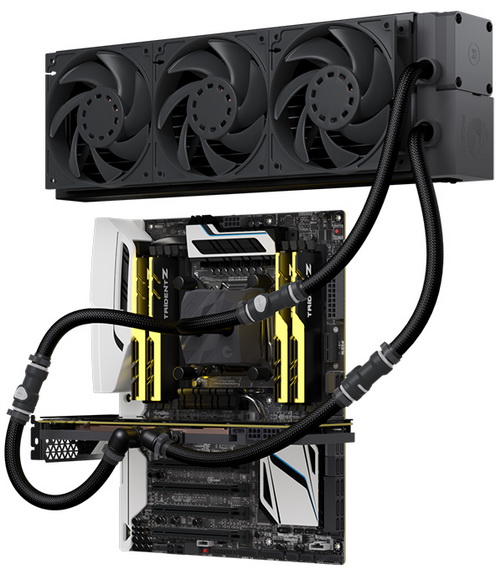
The Predator line of expandable AIO liquid CPU coolers combined impressive cooling efficiency with superior build quality so EK Waterblocks had their job cut out for them when they decided to replace it with the Phoenix MLC. Of course if you’ve read our Predator reviews then you should know that although the Phoenix MLC is very similar (same PE radiator and SPC pump) it does have some differences including the new Vardar EVO fans (although performance is on par with the non-EVO version), plastic tube holders instead of silver aluminum fittings, EK-ZMT sleeved tubes instead of EK-ZMT regular ones, newly designed waterblock (although still based on their Supremacy line – unfortunately AMD compatibility is limited) and a slightly different expansion/modular system (for optimal performance when adding a GPU waterblock). Unfortunately just like with the Predator series (240/360mm models) the Vardar fans paired with the Phoenix are quite loud at full speed (the pump is not what we'd call inaudible either) so this is obviously not an AIO aimed towards people who are looking for something almost inaudible.
The EK-MLC Phoenix 360 Core module is currently available directly from EK Waterblocks for 197.94Euros, the CPU Cooling Module is available for 69.77Euros (62.47Euros for the Threadripper module) and the GPU module for NVIDIA GTX/Titan X cards is available for 130.20Euros (140.63Euros for the AMD Vega module). This means that even with just the CPU module alone the EK-MLC Phoenix 360 will set you back roughly 270Euros while by also adding the GPU module the price will increase to around 400Euros. This of course is the single serious drawback of the EK-MLC Phoenix 360 and although it’s still cheaper than a high-end custom water cooling kit its primary target audience is still enthusiasts, overclockers and professionals. At the end of the day EK Waterblocks has released yet another top AIO liquid cooling system and although it’s far from affordable thanks to its performance and expandability similar to that of custom water cooling kits it gets our Platinum Award.

PROS
- Excellent Build Quality
- Top Of The Line Cooling Efficiency
- CPU & GPU Cooling Modules (Expandable)
- Powerful EK-SPC 60A pump (450 l/h)
- SATA Power Connector
- Quick Disconnect Coupling
- Sleeved Tubes
CONS
- Price (For Some)
- Limited AMD Support (AM4 and sTR4 Sockets)
- Noise Levels (Full Speed)

 O-Sense
O-Sense











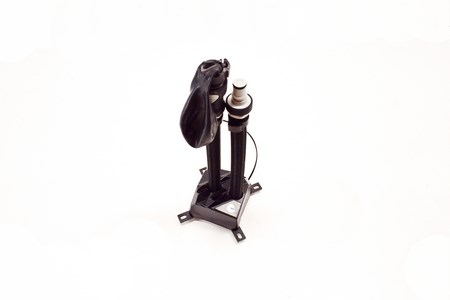









.png)

